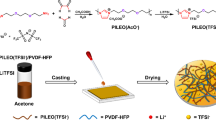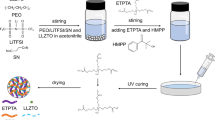Abstract
Employing the solid polymer electrolyte (SPE) instead of traditional liquid electrolyte is an effective way to develop high safety and high-energy density solid-state lithium batteries. Herein, for the first time, the Ni3B2O3 (NBO) nanorods are incorporated into polyethylene oxide (PEO)-based SPE. Particularly, the optimized NBO-embedded SPE shows a high ionic conductivity of 8.5 × 10−5 S cm−1 at 30 °C, lowering the operating temperature of PEO-based SPE substantially. The corresponding LiFePO4/Li battery demonstrates a high discharge capacity of 154 mAh g−1 after 80 cycles at 0.2 C under 30 °C, with favorable capacity retention of 97.5%. The remarkable properties are attributed to the high ionic conductivity of modified SPE at ambient temperature, which is resulted from the decreased crystallinity and melting transition point, increased movement of PEO chain, and promotion of lithium salt dissociation, as well as the formation of the lithium ion migrating pathway on the interface between PEO and NBO nanorods.





Similar content being viewed by others
References
**a S, Wu X, Zhang Z, Cui Y, Liu W (2019) Chem 5:753–785
Janek J, Zeier WG (2016) Nat Energy 1:1–4
Li M, Lu J, Chen Z, Amine K (2018) Adv Mater 30:1800561
Sun C, Liu J, Gong Y, Wilkinson DP, Zhang J (2017) Nano Energy 33:363–386
Shoji, M., Cheng, E. J., Kimura, T. & Kanamura, K. J. of Ph. D: Appl. Phys. 52 (2019) 103001.
Miura A et al (2019) Nat Rev Chem 3:189–198
Jiang Y et al (2018) Polymers 10:1237
Liu, X., Li, X., Li, H. & Wu, H. B. Chemistry–A European Journal 24 (2018) 18293–18306.
Xu L et al (2018) Joule 2:1991–2015
Cheng X-B, Zhao C-Z, Yao Y-X, Liu H, Zhang Q (2019) Chem 5:74–96
Fan L, Wei S, Li S, Li Q, Lu Y (2018) Adv Energy Mater 8:1702657
Kotobuki, M. Polymer electrolytes. polymer electrolytes: characterization techniques and energy applications, Weinheim, Germany (2020).
Weston J, Steele B (1982) Solid State Ionics 7:75–79
Croce F, Appetecchi G, Persi L, Scrosati B (1998) Nature 394:456–458
Zhu Y, Cao J, Chen H, Yu Q, Li B (2019) J of Mater Chem A 7:6832–6839
Lin D et al (2016) Nano Lett 16:459–465
Yu J et al (2019) Small 15:1902729
Croce F, Settimi L, Scrosati B (2006) Electrochem Comm 8:364–368
Reddy MJ, Chu PP, Kumar JS, Rao US (2006) J Power Sources 161:535–540
Li Y et al (2020) J of Mater Chem A 8:2021–2032
Itoh T, Ichikawa Y, Uno T, Kubo M, Yamamoto O (2003) Solid State Ionics 156:393–399
Sun H, Takeda Y, Imanishi N, Yamamoto O, Sohn HJ (2000) J Electrochem Soc 147:2462–2467
Yuan C et al (2013) J Power Sources 240:653–658
Suriyakumar S et al (2016) RSC Adv 6:97180–97186
Zhang Z et al (2020) ChemElectroChem 7(1):125–1134
Li S et al (2020) Adv Sci 7:1903088
Liu W, Lin D, Sun J, Zhou G, Cui Y (2016) ACS Nano 10:11407–11413
Liu W et al (2017) Nat Energy 2:1–7
Sheng O et al (2018) Nano Lett 18:3104–3112
Effenberger H, Pertlik F (1984) ZEITSCHRIFT FUR KRISTALLOGRAPHIE 166:129–140
Pang H, Lu QY, Chen CY, Liu XR, Gao F (2011) J Mater Chem 21:13889–13894
Chen AM, Hu FC, Gu P, Ni ZM (2011) Chin J Inorg Chem 27:30–34
Zhang H et al (2014) Electrochim Acta 133:529–538
Molinari N, Mailoa JP, Kozinsky B (2018) Chem Mater 30:6298–6306
Zheng J, Hu Y-Y (2018) ACS Appl Mater Inter 10:4113–4120
Zhou D, Mei X, Ouyang J (2011) J Phys Chem C 115:16688–16694
Xue Z, He D, **e XJ (2015) Mater Chem A 3:19218–19253
Klongkan S, Pumchusak J (2015) Electrochim Acta 161:171–176
Masoud E, El-Bellihi A-A, Bayoumy W, Mousa M (2013) Mater Res Bull 48:1148–1154
Tikekar MD, Archer LA, Koch DL (2016) Sci Adv 2:15
Wang C et al (2017) ACS Appl Mater Inter 9:13694–13702
Liu W et al (2015) Nano Lett 15:2740–2745
Lin Y, Wang X, Liu J, Miller JD (2017) Nano Energy 31:478–485
Wen SJ et al (1996) J Electroanal Chem 408:113–118
Funding
This work was supported by the National Natural Science Foundation of China [51804344, 51704332], the Natural Science Foundation for Distinguished Young Scholars of Hunan Province [2020JJ2047], the Program of Huxiang Young Talents [2019RS2002], and the Innovation-Driven Project of Central South University [ 2020CX027]. Dr. J. Wang also appreciated the support from Furong Scholar Program.
Author information
Authors and Affiliations
Corresponding author
Ethics declarations
Conflict of interest
The authors declare no competing interests.
Additional information
Publisher's note
Springer Nature remains neutral with regard to jurisdictional claims in published maps and institutional affiliations.
Supplementary Information
Below is the link to the electronic supplementary material.
Rights and permissions
About this article
Cite this article
Guo, Z., Wu, Y., Li, X. et al. Lowering the operating temperature of PEO-based solid-state lithium batteries via inorganic hybridization. Ionics 28, 779–788 (2022). https://doi.org/10.1007/s11581-021-04291-8
Received:
Revised:
Accepted:
Published:
Issue Date:
DOI: https://doi.org/10.1007/s11581-021-04291-8




